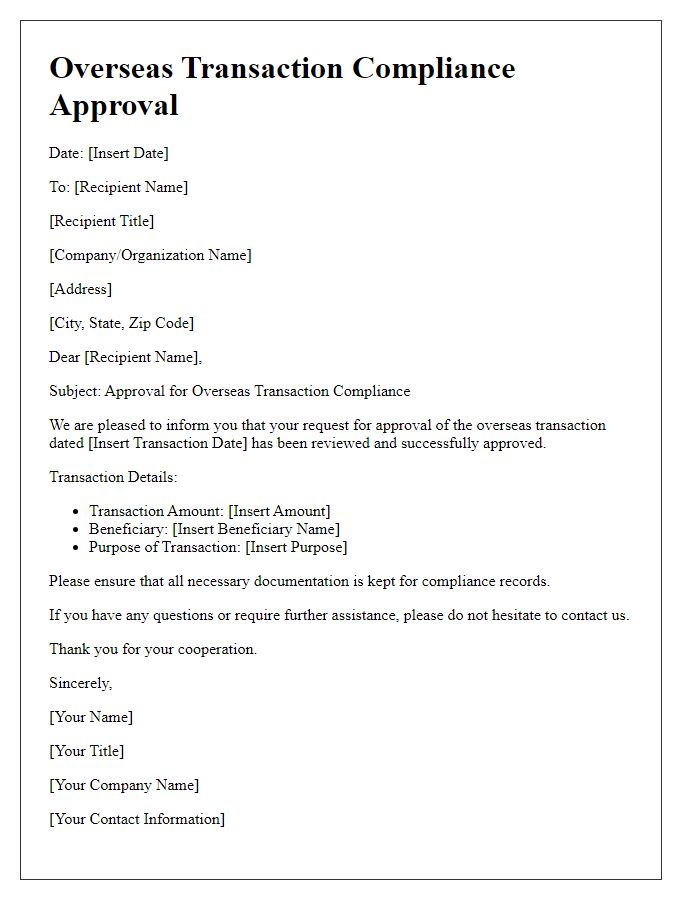Navigating overseas transactions can often feel overwhelming, especially with the numerous compliance regulations in place. It's crucial to understand what documents are required and how to ensure your transactions meet international standards to avoid any potential pitfalls. With the right guidance and a clear approach, managing these affairs can be much simpler and more efficient. Join me as we explore essential tips and a practical letter template for overseas transaction compliance to help smooth your journey!

Regulatory Requirements
Overseas transaction compliance is governed by various regulatory requirements established by financial institutions and government bodies. Regulations such as the Financial Action Task Force (FATF) guidelines necessitate that banks like JPMorgan Chase conduct thorough customer due diligence, particularly for transactions exceeding $10,000. The Anti-Money Laundering (AML) regulations require enhanced scrutiny of foreign transactions to mitigate risks associated with money laundering and terrorist financing. Jurisdictions may mandate reporting to the Financial Crimes Enforcement Network (FinCEN) for cross-border payments. Additionally, the Office of Foreign Assets Control (OFAC) oversees restricted entities, requiring businesses to implement sanctions screening measures to prevent dealings with designated individuals or countries. Compliance entails meticulous record-keeping, including transaction details and the parties involved, to ensure audit readiness and adherence to legal standards.
Transaction Details
Overseas transactions often require meticulous documentation and compliance with regulations set by international financial authorities. Transaction details should include specific information such as the date of transaction (critical for record-keeping), amount (denominated in both local and foreign currency), beneficiary account details (including the bank name, account number, and SWIFT code), and purpose of the transaction (to clarify compliance with anti-money laundering laws). Additional relevant details like regulatory reference numbers or invoice identifiers may also be essential to meet local and international legal obligations, particularly when dealing with larger sums or high-risk jurisdictions. Careful attention should be paid to ensure all information adheres to the guidelines set forth by regulatory bodies such as the Financial Action Task Force (FATF) or the U.S. Department of the Treasury's Office of Foreign Assets Control (OFAC).
Verification Documents
Verification documents are essential for ensuring compliance in overseas transactions, particularly under the regulations set by financial oversight authorities like the Financial Action Task Force (FATF). These documents often include personal identification, such as government-issued photo IDs (e.g., passports), proof of address like utility bills or bank statements (typically less than three months old), and business licenses for corporate entities. Additionally, transaction-specific documentation may be required, such as invoices or contracts detailing the nature of the business or service exchanged, as well as payment methods used (like wire transfers). Collecting and submitting these verification documents is crucial for mitigating risks related to money laundering and fraud, proving the legitimacy of both parties in the transaction.
Authorized Signatures
Overseas transaction compliance necessitates the presence of authorized signatures, essential for verifying the authenticity of financial documents. In financial institutions, such as banks or credit unions, these signatures must be from individuals with legal authority to conduct international transactions, often including executive officers or designated compliance officers. Regulatory bodies, like the Financial Crimes Enforcement Network (FinCEN) in the United States, require these signatures to ensure adherence to anti-money laundering (AML) protocols and due diligence requirements. Each signature on a transaction document must match the approved specimen signatures maintained in the institution's records. Furthermore, specific transactions may require additional verification through certifications or stamps, ensuring all parties are protected during the process.
Compliance Statement
The compliance statement for overseas transactions emphasizes adherence to international financial regulations and anti-money laundering (AML) laws governing cross-border payments. It requires entities to conduct due diligence on foreign partners, ensuring that all transactions comply with the guidelines set forth by organizations such as the Financial Action Task Force (FATF) and respective local authorities. Ongoing risk assessments are crucial, evaluating factors like the countries involved, transaction amounts over specific thresholds (e.g., EUR10,000), and the nature of the business relationship. Documentation must include detailed records of transactions, customer identification, and verification processes to meet regulatory standards and facilitate audits by compliance officers. Non-compliance could lead to severe penalties, including fines exceeding millions of dollars, reputational harm, and potential criminal charges.













Comments